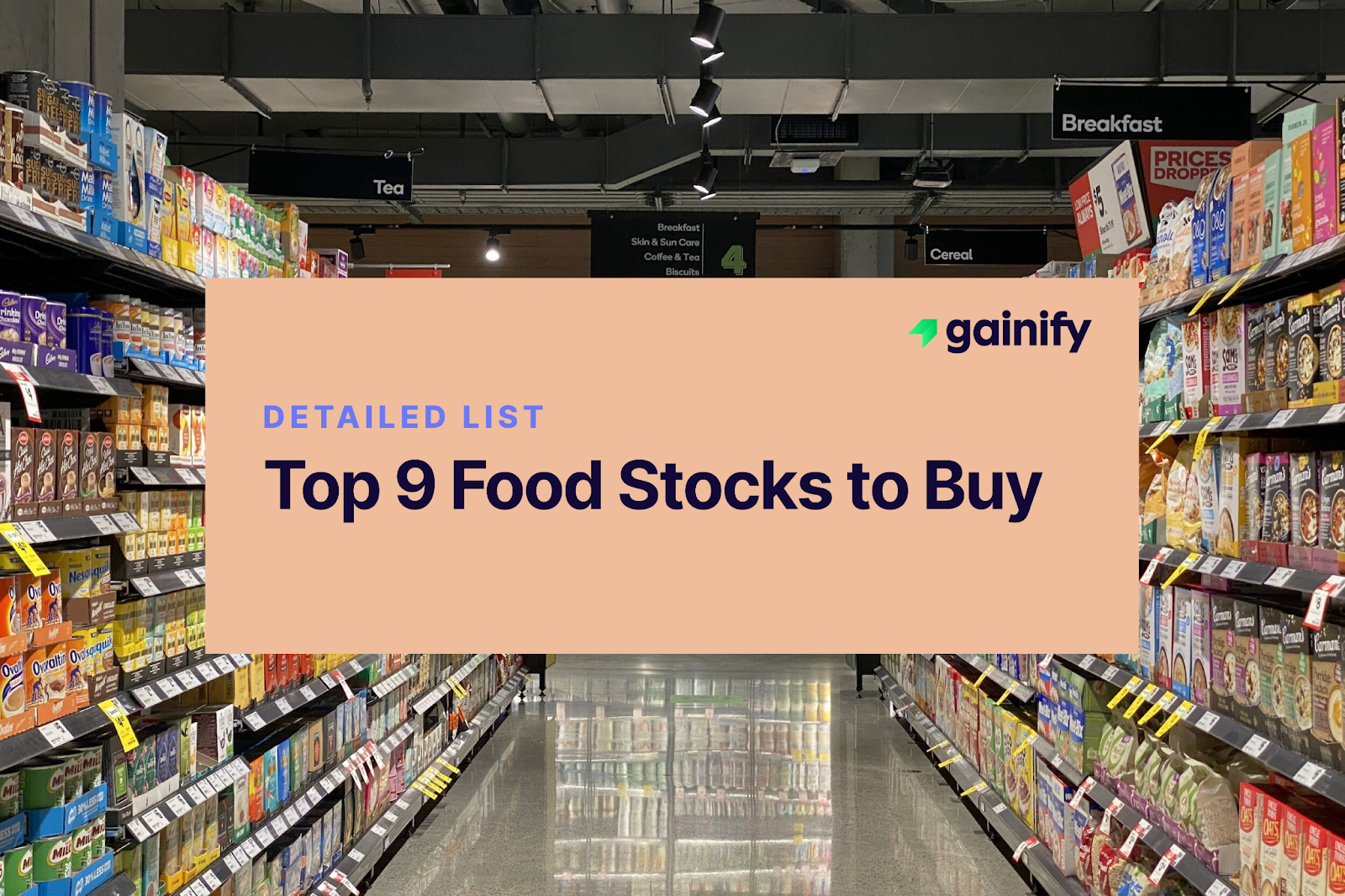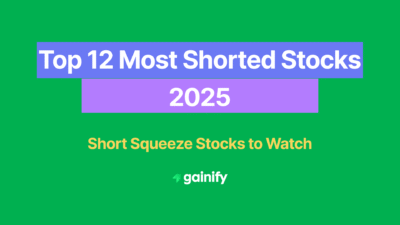There is a noticeable shift in how investors are approaching sector allocation. While the spotlight continues to focus on high-growth technology and artificial intelligence, a quieter story is playing out in the background.
Food stocks are gaining renewed attention not because they are explosive, but because they offer something many investors now value more than ever: stability, consistent cash flow and dividends.
This year, the sector has kept pace with the S&P 500, proving its defensive strength even in a volatile market. Trusted household brands continue to deliver repeat business, pricing power, and consistent earnings.
In this article, we highlight 9 of the best food stocks to buy in 2025. These companies are selected not for hype or speculation, but for their ability to deliver long-term shareholder value through strong fundamentals.
Nine Food Stocks to Consider Buying in 2025 by Market Cap
Before diving into the full breakdown, here’s a snapshot of the nine food stocks that stand out in 2025.
# | Company | Ticker(s) | Why It Stands Out |
|---|---|---|---|
1 | NSRGY | Global scale, diversified brands, strong cash flow | |
2 | PEP | Beverage + snacks synergy, Dividend Aristocrat | |
3 | MDLZ | Snacking leader, pricing power, global reach | |
4 | LDSVF | Premium chocolate brand with margin focus | |
5 | KHC | Deep brand roster, high yield, turnaround play | |
6 | GIS | Stable staple business, diverse product lines | |
7 | TSN | Leading protein producer, structure & scale | |
8 | HRL | Long dividend streak, brand consistency | |
9 | MKC | Flavor business + global distribution |
More detail about each of these stocks, including business strengths and investment risks, is provided in the sections below.
1. Nestlé SA (NSRGY)
- Market Cap: USD 240 billion
- 2024 Revenue: USD 101 billion
- Valuation: 2025 estimated P/E ratio of 16.8
- Dividend yield: 4.2%
Why it stands out: Nestlé is the largest food company in the world, with a deeply diversified portfolio that spans nearly every major consumer category. Its product mix includes globally recognized brands such as Nescafé, KitKat, Purina, Gerber, Nestlé Health Science, and San Pellegrino. The company has built category leadership in coffee, pet nutrition, infant formula, bottled water, and clinical nutrition, positioning it as an indispensable player in both staple and specialized food markets.
Nestlé continues to benefit from consistent global demand, strong pricing power, and disciplined operational execution. Its wide distribution footprint and ability to scale innovation across brands help protect margins and support durable earnings. The company has maintained a long history of annual dividend increases, underpinned by healthy free cash flow and high return on invested capital.
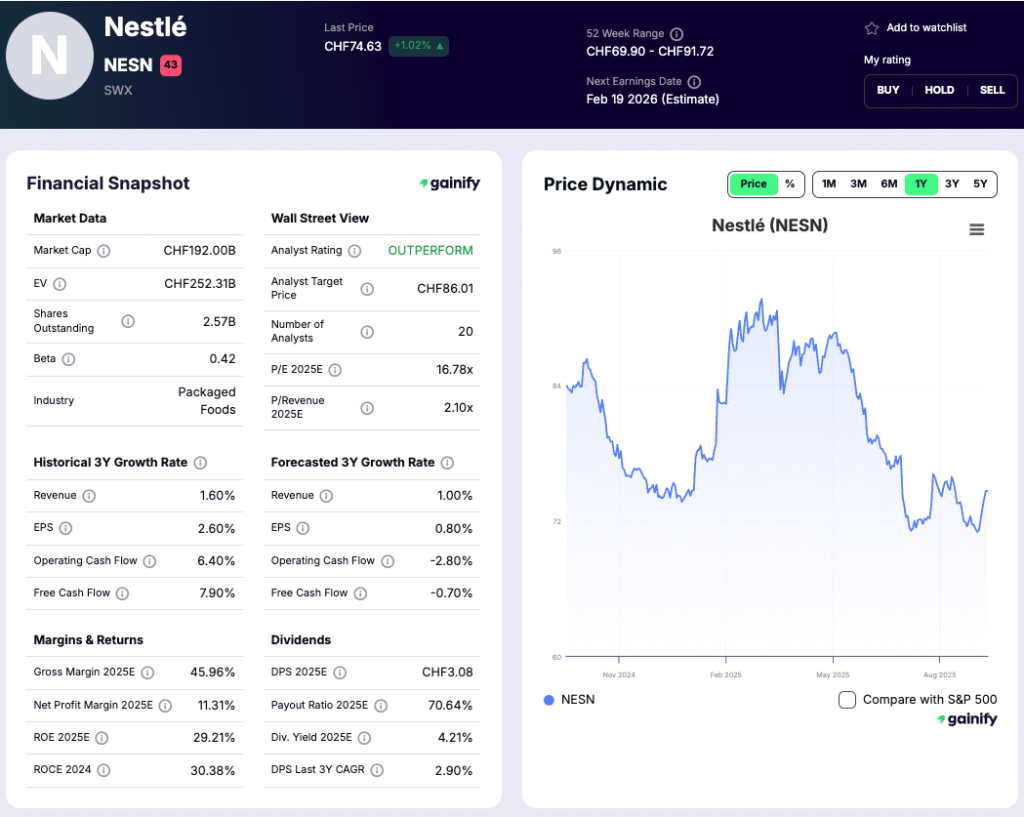
2. PepsiCo Inc. (PEP)
- Market Capitalization: USD 181 billion
- 2024 Revenue: USD 92 billion
- Valuation: 2025 estimated P/E ratio of 16.6
- Dividend Yield: 4.3%
Why it stands out: PepsiCo is one of the most well-rounded food and beverage companies globally, combining iconic soft drinks with a dominant presence in snacks and packaged foods. Its portfolio includes household names such as Pepsi, Mountain Dew, Gatorade, Tropicana, Lay’s, Doritos, Quaker, and Cheetos. The company operates through two highly complementary divisions: beverages and Frito-Lay snacks that together offer balanced revenue streams across product types and regions.
PepsiCo benefits from strong brand equity, deep penetration in both developed and emerging markets, and broad shelf presence across grocery stores, mass merchandisers, and convenience retailers. The company has built a reputation for reliable earnings and is a member of the Dividend Aristocrats index, with more than 50 consecutive years of annual dividend increases. Its cash flow generation supports ongoing capital returns while also funding innovation and global expansion.
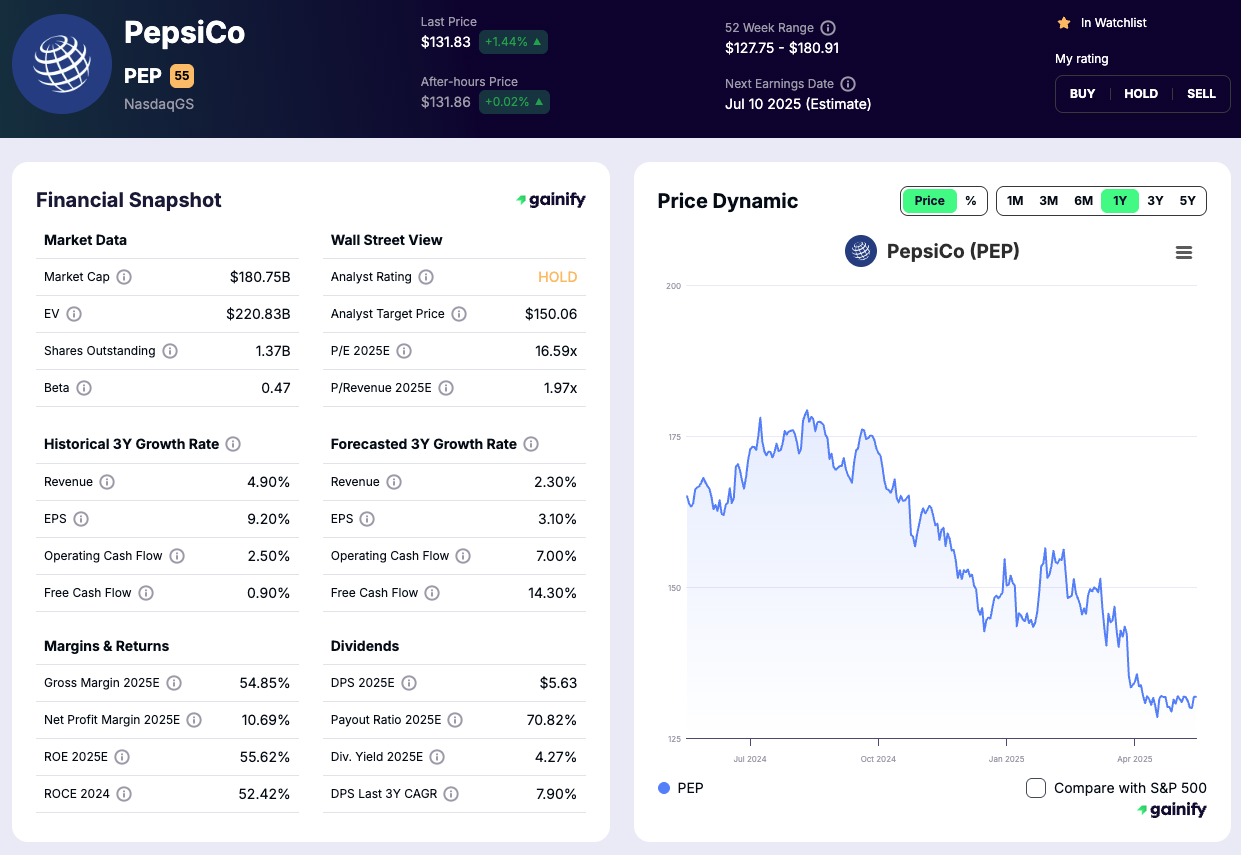
3. Mondelez International (MDLZ)
- Market Capitalization: USD 87 billion
- 2024 Revenue: USD 36.4 billion
- Valuation: 2025 estimated P/E ratio of 22.3
- Dividend Yield: 2.9%
Why it stands out: Mondelez International is a global leader in snacking, with a portfolio that includes some of the most recognizable consumer brands in the world. Its core offerings include Oreo, Ritz, Cadbury, Toblerone, Trident, and BelVita, giving it a dominant position in biscuits, chocolate, and gum. These brands hold strong market share in both mature and emerging markets, contributing to reliable revenue growth and brand-driven pricing power.
The company continues to outperform the broader food industry average in snack category sales, driven by strategic innovation and well-executed marketing. Mondelez has also expanded into higher-growth areas through acquisitions in premium, organic, and better-for-you product segments. While not a plant-based specialist, it has selectively added plant-forward and sustainable options to meet evolving consumer expectations.
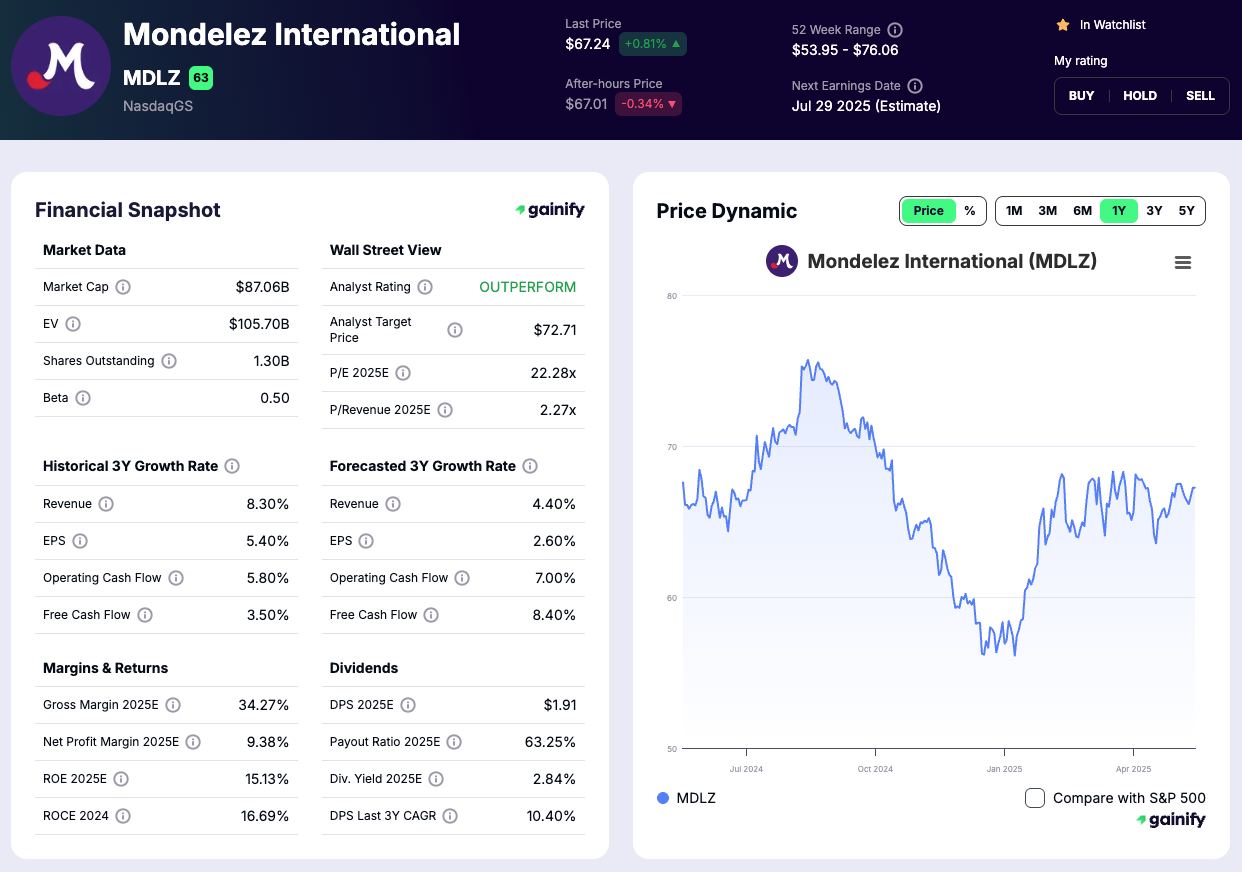
4. Lindt & Sprüngli (LDSVF)
- Market Capitalization: USD 36.7 billion
- 2024 Revenue: USD 6.1 billion
- Valuation: 2025 estimated P/E ratio of 37.3
- Dividend Yield: 1.2%
Why it stands out: Lindt & Sprüngli is a global leader in premium chocolate, known for its artisanal quality, iconic packaging, and strong brand identity. Its portfolio includes Lindt, Ghirardelli, and Russell Stover, making it a dominant force in the high-margin confectionery segment. The company also benefits from its positioning as a luxury gift brand, especially during seasonal periods when demand for high-quality chocolate is strongest.
Despite facing elevated input costs from unprecedented cocoa price inflation, Lindt continues to deliver solid operating results. Its pricing power, loyal customer base, and focus on quality allow it to protect margins more effectively than many peers. The company’s international retail strategy, which includes branded stores and boutiques, enhances brand visibility and helps it reach affluent consumers in global markets.
5. Kraft Heinz Co. (KHC)
- Market Capitalization: USD 31.5 billion
- 2024 Revenue: USD 25.9 billion
- Valuation: 2025 estimated P/E ratio of 10.2
- Dividend Yield: 6.0%
Why it stands out: Kraft Heinz remains one of the most recognized names in the packaged food industry, with a portfolio that includes Kraft, Heinz, Oscar Mayer, Velveeta, and Philadelphia Cream Cheese. These products enjoy broad shelf space in grocery stores and mass merchandisers, supporting consistent demand across a wide consumer base. The company is undergoing a strategic product portfolio transformation, introducing more sustainable food options and better-for-you formulations while maintaining its focus on affordability and convenience.
Kraft Heinz has also made progress in streamlining operations and improving cost efficiency. Management continues to invest in digital supply chain tools, consumer insights, and innovation to drive relevance in a competitive retail environment. The company’s approach to modernization has earned renewed attention from long-term investors and analysts alike. Importantly, Warren Buffett’s Berkshire Hathaway remains a significant long-term shareholder in Kraft Heinz, reinforcing investor confidence in the company’s value proposition and long-term outlook.
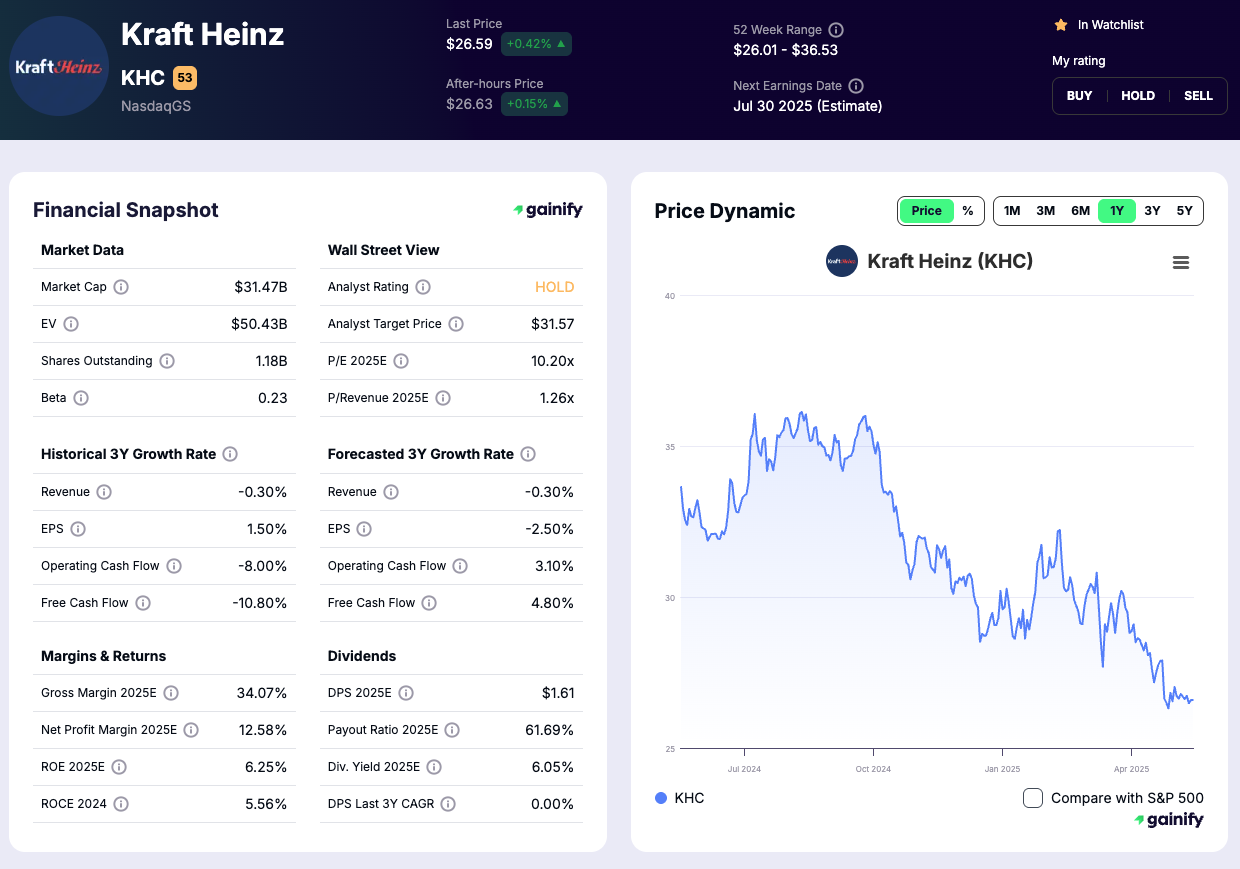
6. General Mills Inc. (GIS)
- Market Capitalization: USD 29.9 billion
- 2024 Revenue: USD 19.9 billion
- Valuation: 2025 estimated P/E ratio of 13.0
- Dividend Yield: 4.5%
Why it stands out: General Mills is one of the most established food producers in North America, known for its stable earnings and broad consumer reach. Its brand portfolio includes iconic names such as Cheerios, Betty Crocker, Nature Valley, Pillsbury, Blue Buffalo, and Annie’s. These products are staples in households across the United States and continue to perform well in grocery stores, mass retailers, and an increasing number of health-focused and convenience store formats.
The company’s balanced presence across core categories – cereal, baking products, snacks, and pet food allows it to generate dependable revenue and free cash flow. It has also invested in higher-margin, organic, and natural brands that cater to changing consumer preferences. General Mills has maintained a steady pace of innovation while carefully managing costs and expanding distribution.
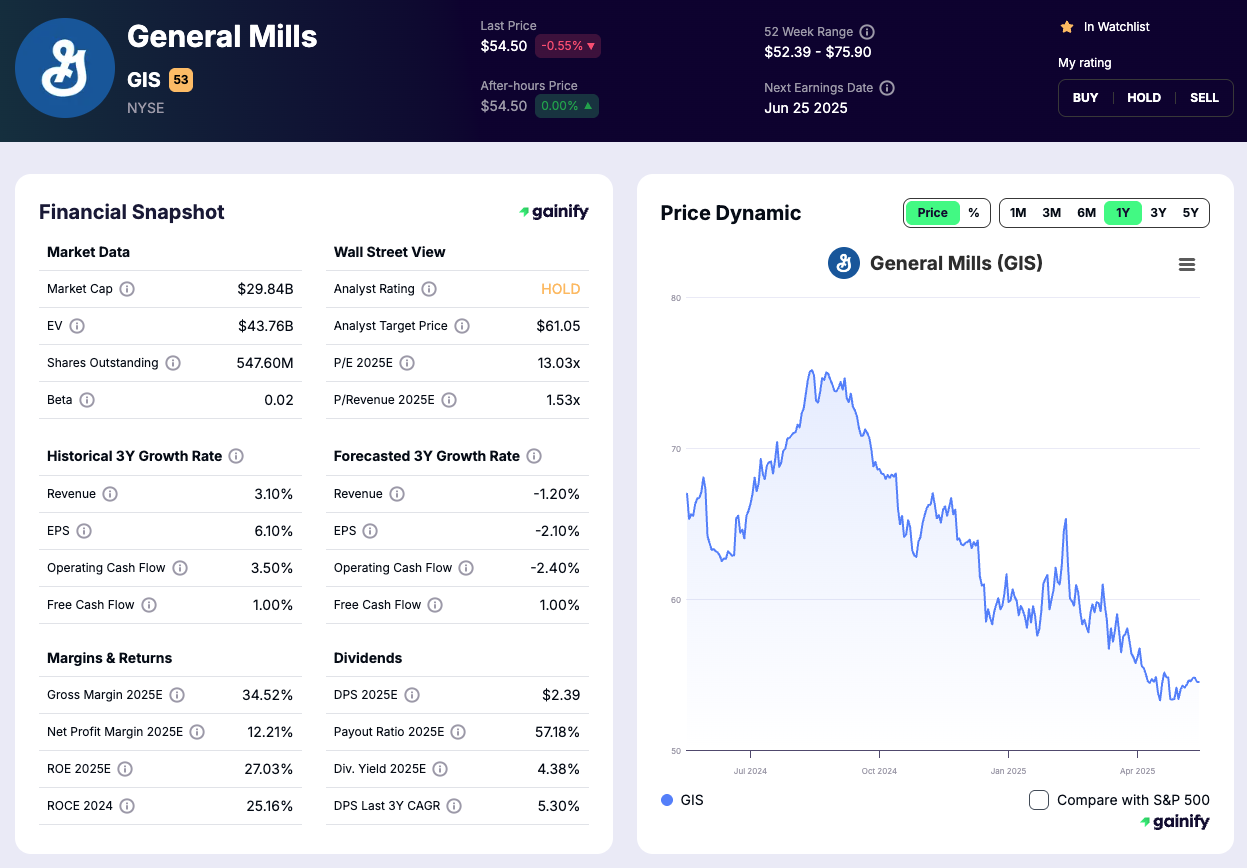
7. Tyson Foods Inc. (TSN)
- Market Capitalization: USD 19.9 billion
- 2024 Revenue: USD 53.3 billion
- Valuation: 2025 estimated P/E ratio of 14.8
- Dividend Yield: 3.6%
Why it stands out: Tyson Foods is one of the largest meat producers in the world, with a leading role in supplying chicken, beef, and pork to food service operators, grocery chains, and mass merchandisers. Its brand portfolio includes Tyson, Hillshire Farm, Jimmy Dean, Ball Park, and Aidells, all of which have strong presence across the U.S. retail sector. Tyson plays a central role in the global protein supply chain and remains a cornerstone of meat consumption in both domestic and international markets.
The company has faced recent challenges, including declining volume in certain segments and margin pressure from input costs. However, Tyson is taking meaningful steps to restructure operations, improve its food supply chain efficiency, and modernize its distribution networks. These actions are designed to restore earnings stability and enhance cost control over the medium term.
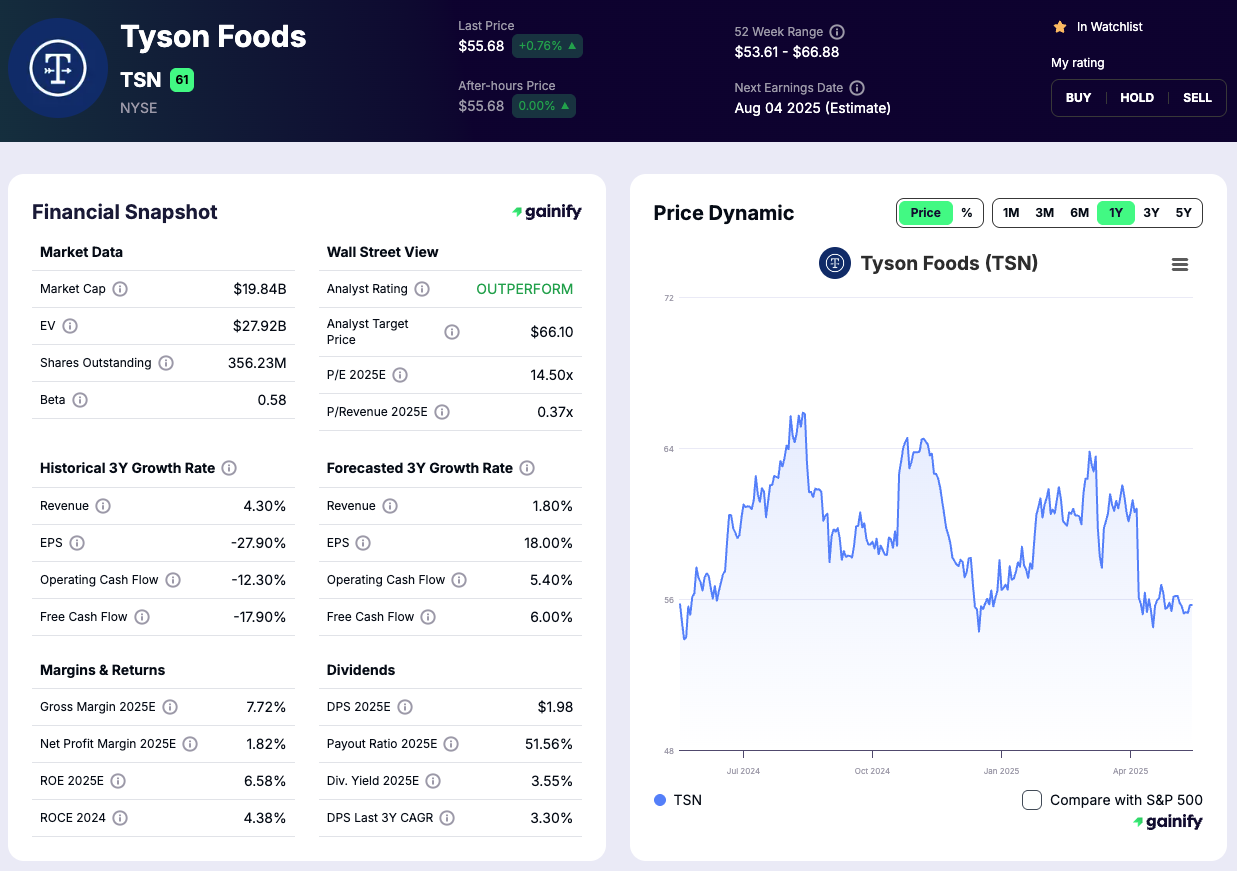
8. Hormel Foods Corp. (HRL)
- Market Capitalization: USD 17.1 billion
- 2024 Revenue: USD 11.9 billion
- Valuation: 2025 estimated P/E ratio of 19.6
- Dividend Yield: 3.8%
Why it stands out: Hormel Foods is one of the most consistent income-generating companies in the food industry, with over 50 consecutive years of quarterly dividend payments and annual dividend increases. It operates across key protein and prepared food categories, with well-known brands including Spam, Applegate, Jennie-O, Skippy, and Planters. These products cater to both traditional grocery demand and the growing interest in health-conscious and natural food options.
Hormel’s long-standing reputation for financial discipline, strong cost controls, and supply chain efficiency gives it a competitive edge in managing input volatility and protecting margins. The company’s focus on branded retail products and value-added protein solutions continues to support stable revenue and operating income across economic cycles.
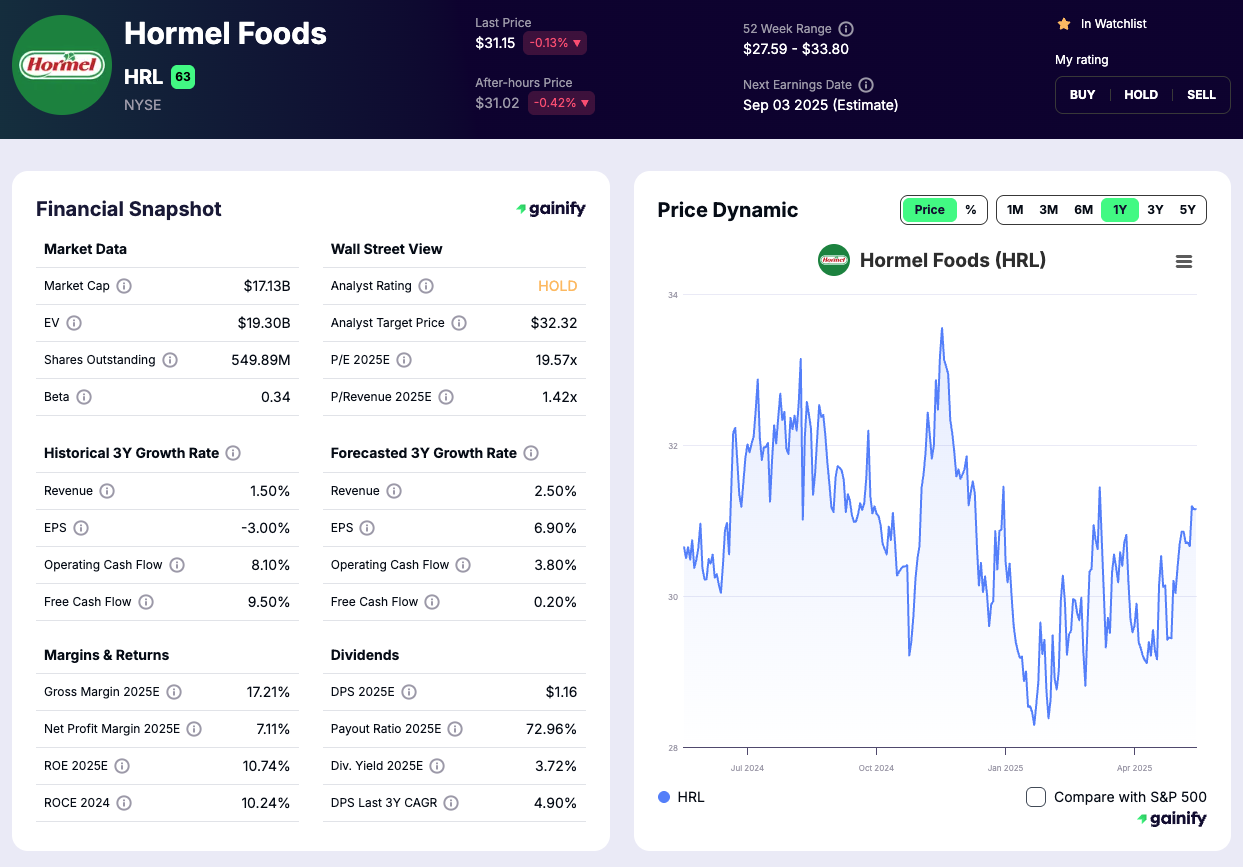
9. McCormick & Company (MKC)
- Market Capitalization: USD 20 billion
- 2024 Revenue: USD 6.7 billion
- Valuation: 2025 estimated P/E ratio of 24.8
- Dividend Yield: 2.4%
Why it stands out: McCormick & Company is the global leader in spices, herbs, seasonings, and flavor solutions. Its portfolio includes the flagship McCormick brand along with French’s, Frank’s RedHot, Lawry’s, and Old Bay. These brands hold leading market share across both retail and food service channels, making McCormick a key player in both home cooking and restaurant supply.
The company benefits from strong pricing power, scalable production, and a global distribution footprint that spans over 150 countries. McCormick’s dual business model – consumer products and flavor solutions for industrial customers provides a diversified revenue stream and enhances its ability to navigate fluctuations in consumer demand or input costs.
New Trends Shaping the Food Industry
The global food industry is undergoing one of its most significant transformations in decades. This is not just a matter of shifting tastes or updated packaging. It represents a fundamental rethinking of how food is grown, produced, distributed, and consumed. These changes are being driven by rising consumer expectations, new technologies, and growing demands for environmental and social accountability. For investors, understanding these trends is critical to identifying which companies are best positioned to lead over the long term.
A key driver of change is the increasing demand for sustainable and ethically sourced food. Today’s consumers are asking questions about where their food comes from, how it is made, and what impact it has on their health and the planet. In response, leading food producers are investing in transparency tools, regenerative agriculture, and climate-resilient sourcing strategies. Companies that can verify and communicate the integrity of their supply chains are gaining customer loyalty and outperforming competitors in both mature and emerging markets.
Health and wellness priorities are also reshaping food portfolios. Although interest in highly processed plant-based alternatives has cooled, there is strong and growing demand for organic products, clean-label ingredients, and functional foods that provide real nutritional value. Categories such as protein-rich snacks, gut health, and immune-supporting beverages are expanding as consumers seek more than just calories from their food. Major brands are increasing their focus on these areas through both product development and targeted acquisitions.
Operationally, efficiency has become a top priority. Food companies are implementing advanced inventory systems, real-time demand forecasting, and automated logistics to improve margins and reduce waste. With ongoing volatility in agricultural prices and energy markets, companies that can manage supply chain complexity while maintaining service levels are building a clear advantage. Improved visibility into production and distribution networks is no longer a competitive edge. It is quickly becoming a requirement.
In the broader investment landscape, established food producers are partnering with or acquiring startups in agri-tech, cellular agriculture, and sustainable food innovation. Collaborations with firms like CULT Food Science reflect a growing recognition that innovation cannot be delayed. It must be embedded directly into the business model. These strategic moves allow legacy companies to expand their capabilities while reducing risk exposure to untested technologies.
The future of food will be shaped by more than flavor and price. It will be defined by transparency, trust, and adaptability. Investors who pay attention to which companies are modernizing their operations and meeting new consumer standards will be better positioned to capture sustainable returns in a rapidly changing global market.
Contrarian View: Are Food Stocks Too Predictable?
Some critics argue that food stocks offer limited upside. Compared to sectors like technology or clean energy, food companies tend to deliver slower growth and less dramatic stock price movement. Concerns about pressured household budgets and rising competition from private-label brands continue to weigh on sentiment for some investors.
However, this view often misses what food stocks consistently provide: reliable income, low volatility, and strong relative performance in turbulent markets. Their ability to generate stable earnings, maintain dividends, and hold market share in downturns gives them lasting value. While they may not lead during speculative rallies, food stocks remain a foundation for investors focused on long-term wealth and portfolio stability.
For some, the very predictability of these companies is the appeal. In an investment environment shaped by inflation cycles, geopolitical risk, and uneven economic growth, food stocks act as an anchor. Their products are essential, their revenues repeatable, and their brands deeply embedded in everyday life. For investors seeking consistent returns rather than market-chasing bets, food remains one of the most strategically sound sectors in the equity landscape.
Final Thoughts
The best food stocks in 2025 are not just safe investments.
They are reliable, slowly growing businesses that meet the essential needs of the modern consumer. These companies have adapted to market shifts, responded to economic pressures, and are actively shaping the future of food through innovation, sustainability, and disciplined execution.
Whether you are focused on dividend yield, sales growth, or steady earnings, these food stocks can offer security, performance, and peace of mind in a volatile market. They remain one of the most undervalued and underestimated categories in the entire stock market today.
Frequently Asked Questions
Q: What food stocks pay the most reliable dividends?
A: Hormel Foods, McCormick, and PepsiCo are known for dependable dividend payments. All three companies have long histories of increasing their dividends every year and are considered strong choices for investors looking for steady income.
Q: Can I invest in food stocks through an ETF instead of picking individual companies?
A: Yes. Exchange-traded funds like XLP (Consumer Staples Select Sector SPDR) and PBJ (Invesco Food & Beverage ETF) let you invest in a broad mix of food and beverage companies. These funds include major players and also give you exposure to smaller, fast-growing brands.
Q: Why do investors consider food stocks a safe investment?
A: Food companies sell essential products that people buy regardless of the economy. This gives them consistent sales, which makes their earnings more stable compared to more volatile industries like tech or energy. That stability appeals to investors who want to protect capital and earn steady returns.
Q: Do food stocks perform well during market downturns?
A: Yes. Food stocks are often seen as defensive investments. When markets decline, companies that produce everyday goods like snacks, beverages, and household staples tend to hold their value better than high-growth or speculative sectors.
Q: Are food stocks good for beginners?
A: Food stocks are a great place for beginners to start. They are generally easier to understand than companies in complex industries, and they tend to be less volatile. Their steady growth and dividend income also help build long-term wealth.
Q: How do food companies respond to inflation or rising costs?
A: Many leading food producers can pass higher costs to consumers through price increases, thanks to their strong brand loyalty. Some also reduce packaging sizes or shift to more efficient A: sourcing to manage margins. This ability to adapt helps protect profitability.
Q: What risks should I consider when investing in food stocks?
Key risks include rising input costs, competition from store brands, supply chain disruptions, and shifting consumer preferences. Companies that fail to innovate or manage costs effectively may underperform over time.
Disclaimer
The information provided in this article is for general informational and educational purposes only. It does not constitute investment advice, financial guidance, or a recommendation to buy or sell any securities. All investing involves risk, including the potential loss of principal. Past performance is not indicative of future results. Readers should conduct their own research or consult a licensed financial advisor before making any investment decisions. The author and publisher are not responsible for any actions taken based on the content presented above.
